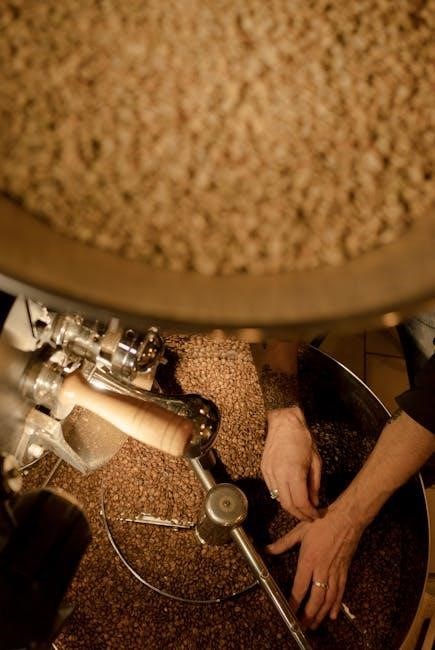
1.1 What Are Manual Coffee Grinders?
Manual coffee grinders are devices that crush coffee beans into precise grind sizes, offering control and flavor. Popular among enthusiasts for their portability, cost-effectiveness, and consistent results.
Manual coffee grinders are devices designed to crush coffee beans into a precise grind size, offering users control over the grinding process. These grinders operate without electricity, relying on manual effort to grind the beans. They are popular among coffee enthusiasts for their portability, cost-effectiveness, and ability to produce consistent results. Manual grinders typically feature a mechanism with two grinding surfaces, such as burrs or blades, that break down the beans into smaller particles. Burr grinders are particularly favored for their ability to produce uniform grind sizes, which is crucial for optimal coffee extraction. Unlike blade grinders, which chop beans inconsistently, burr grinders ensure a precise grind, enhancing the flavor and aroma of the coffee. Manual grinders are a practical choice for those seeking a high-quality coffee experience without the need for advanced equipment.
1.2 Benefits of Using a Manual Grinder
Manual coffee grinders offer numerous benefits for coffee enthusiasts. They are cost-effective and often more affordable than electric grinders. Their portability makes them ideal for travel or camping, allowing you to enjoy freshly ground coffee anywhere. Manual grinders also operate quietly, reducing noise levels compared to electric models. One of the most significant advantages is the ability to control the grind size precisely, which is essential for achieving optimal extraction in various brewing methods. Additionally, manual grinders are easy to clean and maintain, and they do not generate heat, which can preserve the coffee’s natural flavors. The tactile experience of grinding beans manually can also enhance the overall coffee-making process, making it more enjoyable and satisfying for many users.
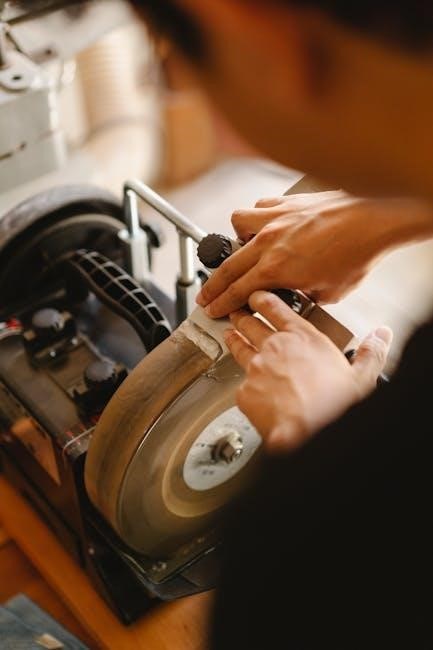
Types of Manual Grinders
Manual grinders are primarily categorized into burr and blade types, each offering distinct advantages. Burr grinders provide consistent particle sizes, while blade grinders are simpler and more affordable.
2.1 Burr Grinders
Burr grinders are highly regarded for their ability to produce consistent particle sizes, which is crucial for optimal coffee extraction. They feature two serrated surfaces, or burrs, where one remains stationary while the other rotates, crushing the beans. This mechanism allows for precise control over grind size by adjusting the distance between the burrs. Burr grinders are preferred by coffee enthusiasts as they minimize heat generation, preserving the beans’ natural flavors and aromas. Additionally, burrs are durable and long-lasting, with options like stainless steel or ceramic. The consistent grind and adjustability make burr grinders ideal for various brewing methods, ensuring a superior coffee experience. They are a worthwhile investment for those seeking high-quality results.
2.2 Blade Grinders
Blade grinders are a cost-effective alternative to burr grinders, utilizing spinning blades to chop coffee beans into smaller particles. Unlike burr grinders, they do not grind but rather slice the beans, often resulting in an inconsistent grind size. This inconsistency can lead to uneven extraction and a potential loss of flavor. Adjusting the grind size is less precise with blade grinders, as it relies on the duration of grinding rather than specific settings. Additionally, the friction from the blades can generate heat, which may degrade the coffee’s quality. While blade grinders are more affordable and quicker for casual use, they are generally not recommended for coffee enthusiasts seeking consistent results. They are best suited for those prioritizing simplicity and cost over precision and flavor consistency.

Choosing the Right Manual Grinder
Selecting the ideal manual grinder involves balancing budget, grind settings, capacity, materials, and ergonomics. Consider your needs to find a grinder that aligns with your preferences and lifestyle.
3.1 Budget Considerations
Budget plays a crucial role in selecting a manual grinder. Entry-level models, like the Timemore Chestnut C2, offer excellent value under $100, providing decent performance for casual users. Mid-range grinders, such as the VSSL Java, feature advanced settings and durability, typically priced between $100-$200. Premium models, often made from high-quality materials like stainless steel or ceramic, can exceed $200 but promise superior consistency and longevity. While higher-priced grinders generally offer better build quality and functionality, affordable options can still deliver satisfactory results for those on a tight budget. Balancing cost with features ensures you find a grinder that meets your needs without compromising on essential performance aspects.
3.2 Grind Settings and Adjustability
Grind settings and adjustability are vital for achieving the perfect brew. Manual grinders with multiple grind settings, such as the VSSL Java Coffee Grinder offering 50 settings, provide precise control. Adjusting the grind size is typically done by turning an adjustment ring—clockwise for finer grinds and counterclockwise for coarser ones. This feature allows customization for various brewing methods, ensuring optimal flavor extraction. For espresso, a fine grind is essential, while French press requires a coarse texture. The ability to fine-tune grind size enhances versatility, making manual grinders suitable for diverse coffee preferences; Look for grinders with clear, defined settings to simplify the process and ensure consistency in every cup. Proper adjustment ensures the best results for any brewing technique, catering to both beginners and coffee enthusiasts alike.
3.3 Capacity and Portability
Capacity and portability are key considerations when selecting a manual grinder. Most manual grinders hold between 0.7 to 3.5 oz (19 to 100 grams) of beans, sufficient for 9 to 10 cups. For home use, larger capacities are convenient, while smaller, compact designs are ideal for travel or camping. Look for lightweight, durable materials like stainless steel or plastic to ensure portability without compromising durability. A grinder’s size and weight significantly impact its ease of transport, making compact models a great choice for on-the-go coffee lovers. Balancing capacity with portability ensures you can enjoy freshly ground coffee anywhere, whether at home or while exploring new destinations. This versatility makes manual grinders a favorite among coffee enthusiasts who value flexibility and convenience in their brewing routine.
3.4 Materials and Build Quality
Materials and build quality significantly impact the performance and longevity of a manual grinder. High-quality grinders often feature stainless steel or ceramic burrs, which provide precise grinding and durability. Stainless steel burrs are resistant to wear and rust, while ceramic burrs are sharp and less likely to generate heat, preserving coffee flavors. The body of the grinder should also be made from durable materials, such as stainless steel, aluminum, or BPA-free plastic, ensuring it withstands regular use. Avoid grinders with flimsy or cheap components, as they may lead to inconsistent grinds or breakage. A well-crafted grinder not only lasts longer but also delivers consistent results, making it a worthwhile investment for coffee enthusiasts. Prioritizing build quality ensures a better brewing experience and extends the life of your manual grinder.
3.5 Ease of Use and Ergonomics

Ease of use and ergonomics are crucial for a seamless manual grinding experience. A well-designed grinder should feature a comfortable handle that reduces fatigue during use. Look for models with an ergonomic grip and a smooth-turning mechanism to minimize effort. The grinder’s size and weight also play a role, with compact designs being ideal for travel. Additionally, intuitive grind adjustment systems ensure effortless changes in grind size. Some grinders offer shorter handles for portability but may require more force, while longer handles provide better leverage. Prioritizing ergonomics and ease of use enhances the overall grinding process, making it enjoyable and efficient for daily use or on-the-go brewing.

Using Your Manual Grinder
Using a manual grinder involves measuring beans, adjusting grind size, and grinding beans consistently. This process ensures optimal flavor and prevents heat buildup, enhancing your coffee experience.
4.1 Measuring Coffee Beans
Measuring coffee beans accurately is crucial for achieving the perfect brew. A general rule is to use two tablespoons of coffee for every 6 to 8 ounces of water. This guideline ensures a balanced flavor and can be adjusted based on personal preference. For precision, a digital scale is recommended, allowing you to weigh the beans and maintain consistency in your brews. Accurate measurement prevents over-extraction or under-extraction, ensuring optimal flavor. By mastering this step, you can tailor your coffee to suit your taste preferences, whether you prefer a stronger or lighter cup. Measuring is the foundation of a great brewing experience, making it essential to get it right before grinding.
4.2 Adjusting the Grind Size
Adjusting the grind size on a manual grinder is straightforward and essential for achieving the desired flavor. Most manual grinders feature an adjustment mechanism, such as a ring or dial, that controls the distance between the burrs. To fine-tune the grind, remove the top nut and handle, then rotate the adjustment ring clockwise for a finer grind or counterclockwise for a coarser grind. Different brewing methods require specific grind sizes, so experiment to find the perfect setting. For example, espresso needs a fine grind, while French press requires a coarse grind. Proper adjustment ensures even extraction and optimal flavor. Take your time to dial in the grind size, as this step directly impacts the quality of your coffee.
4.3 The Grinding Process
The grinding process with a manual grinder is a straightforward yet intentional task. Begin by filling the grinder’s hopper with the measured coffee beans. Secure the handle and ensure the grinder is stable on a flat surface. Hold the grinder firmly and rotate the handle in a steady, clockwise motion. Maintain consistent speed to ensure even grinding. Continue grinding until all beans have been processed. Once complete, gently tap the grinder to release any remaining grounds. Transfer the freshly ground coffee to your brewing device. This method ensures a precise grind and preserves the coffee’s aroma and flavor, making it ideal for various brewing techniques.
4.4 Choosing the Right Grind Size for Different Brewing Methods
Choosing the right grind size is crucial for achieving optimal flavor in various brewing methods. Fine grinds are ideal for espresso, resembling flour, to ensure proper extraction under pressure. Medium-fine grinds work best for pour-over and Aeropress, promoting even extraction. Coarser grinds are suitable for French press and cold brew, allowing oils and sediment to enhance the flavor. For drip coffee, a medium grind size is recommended to balance extraction. Adjusting the grind size on a manual grinder involves turning the adjustment ring clockwise for finer grinds and counterclockwise for coarser ones. Experimenting with these settings ensures the perfect match for your brewing method, enhancing the overall coffee experience.
4.4.1 Common Brewing Methods and Their Grind Sizes
Understanding grind sizes for various brewing methods is key to achieving the perfect cup. Here are the most common methods and their ideal grinds:
- Espresso: Fine grind, resembling flour, for proper extraction under pressure.
- Pour-over/Aeropress: Medium-fine grind for even extraction and balanced flavor.
- French Press: Coarse grind to allow oils and sediment to enhance flavor;
- Drip Coffee: Medium grind size for balanced extraction in automatic brewers.
Each method requires a specific grind size to optimize flavor and aroma. Adjusting the grind size on a manual grinder ensures the perfect match for your brewing technique.
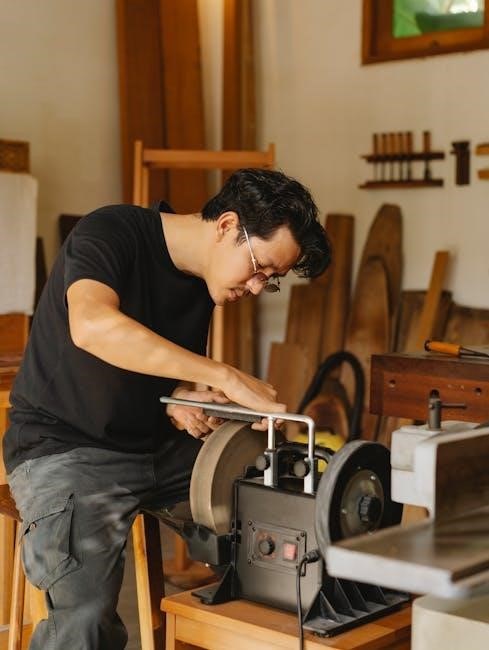
Maintenance and Care
Regularly clean your manual grinder with a soft brush and store it in a dry place. Follow the manufacturer’s guidelines for optimal performance and longevity.
5.1 Cleaning Your Manual Grinder
Cleaning your manual grinder is essential for maintaining flavor and performance. Start by disassembling the grinder, removing the top nut, handle, and locking ring. Use a soft brush or cloth to wipe away coffee residue from the burrs and chambers. Avoid harsh chemicals, as they can damage the materials. For deeper cleaning, rinse with warm water, but ensure all parts are thoroughly dried to prevent rust or mold. Regularly cleaning prevents old coffee oils from affecting the taste of freshly ground beans. For stubborn residue, a small amount of rice can be ground to absorb oils before cleaning. Always follow the manufacturer’s instructions for specific care. Regular maintenance ensures your grinder remains in optimal condition for consistent, flavorful grinds.
5.2 Storing Your Grinder Properly
Proper storage is crucial for maintaining your manual grinder’s performance and longevity. Store it in a cool, dry place to prevent moisture from affecting the burrs and other components. Avoid humid environments, as they can lead to rust or mold. Keep the grinder upright to prevent dust and debris from accumulating inside. Ensure it is placed away from direct sunlight, as heat can warp or degrade materials over time. Before storing, clean the grinder thoroughly to remove any residual coffee oils or particles. Use a soft cloth to wipe down exterior surfaces. Proper storage ensures your grinder remains in optimal condition, ready for consistent and flavorful grinding whenever you need it.
5.3 Regular Maintenance Tips
Regular maintenance is essential to keep your manual grinder functioning smoothly and delivering consistent results. Clean the grinder after each use to remove residual coffee oils and particles. Use a soft brush or cloth to wipe down the burrs and chambers. For deeper cleaning, disassemble the grinder and soak the parts in warm, soapy water, then rinse thoroughly. Avoid harsh chemicals, as they may damage the materials. Lubricate moving parts periodically to ensure smooth operation. Check for wear on the burrs and replace them if necessary to maintain grind quality. Store the grinder in a dry place to prevent rust. By following these tips, you can extend the life of your grinder and ensure it continues to perform at its best.
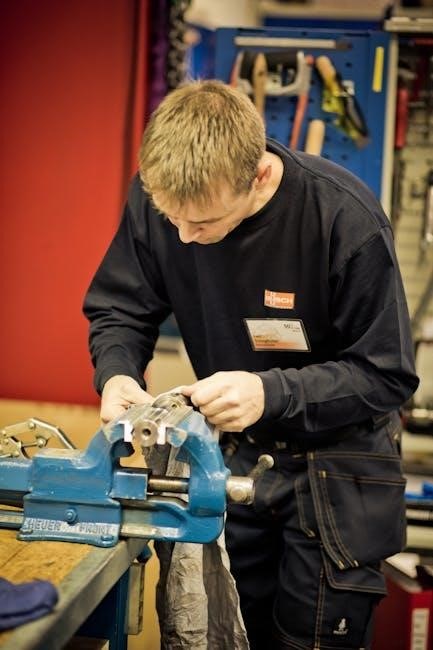
Troubleshooting Common Issues
Troubleshooting common issues with manual grinders involves addressing difficulties in grinding, inconsistent grind sizes, and maintenance-related problems. Regular cleaning, burr alignment, and lubrication often resolve these concerns effectively.
6.1 Difficulties in Grinding
Difficulties in grinding with manual grinders often arise from clogged burrs, uneven grind sizes, or handle resistance. These issues can stem from improper bean feeding, insufficient cleaning, or misaligned burrs. To resolve clogging, clean the grinder thoroughly and ensure beans are dry. For uneven grinds, adjust the burr alignment or check for worn-out parts. Handle resistance can be addressed by grinding smaller batches or lubricating moving components. Regular maintenance, such as brushing out old grounds and aligning burrs, helps prevent these problems. Ensuring consistent bean size and avoiding overloading the grinder also improves grinding efficiency. Addressing these challenges ensures smoother operation and consistent results.
6.2 Inconsistent Grind Size
Inconsistent grind size is a common issue with manual grinders, often caused by misaligned burrs, uneven bean feeding, or improper adjustment. Worn-out burrs can also lead to irregular particle sizes. To address this, ensure the burrs are clean and properly aligned. Check for wear and tear, as damaged burrs may require replacement. Additionally, maintaining a steady grinding motion and using freshly roasted beans can improve consistency. Experimenting with grind settings and adjusting the burrs for uniformity is key. Regular maintenance, such as cleaning and lubricating the grinder, also helps prevent inconsistencies. By addressing these factors, users can achieve a more uniform grind size and enhance their coffee-brewing experience.
6.3 Grinder Maintenance Issues
Grinder maintenance issues often arise from improper care or neglect. Common problems include clogged burrs, worn-out parts, and misaligned mechanisms. Regular cleaning is essential to prevent oil buildup and residue, which can affect grind quality. Use a soft brush to remove coffee particles and occasionally deep clean with a cleaning solution. Check for worn burrs or gears, as they can cause inconsistent grinding. Lubricate moving parts periodically to ensure smooth operation. Misaligned burrs can be adjusted by tightening or loosening the adjustment ring. Failure to address these issues can lead to poor performance or complete malfunction. Proper storage in a dry, clean environment also prevents rust and dust accumulation. Addressing maintenance issues promptly ensures optimal grinder functionality and longevity.
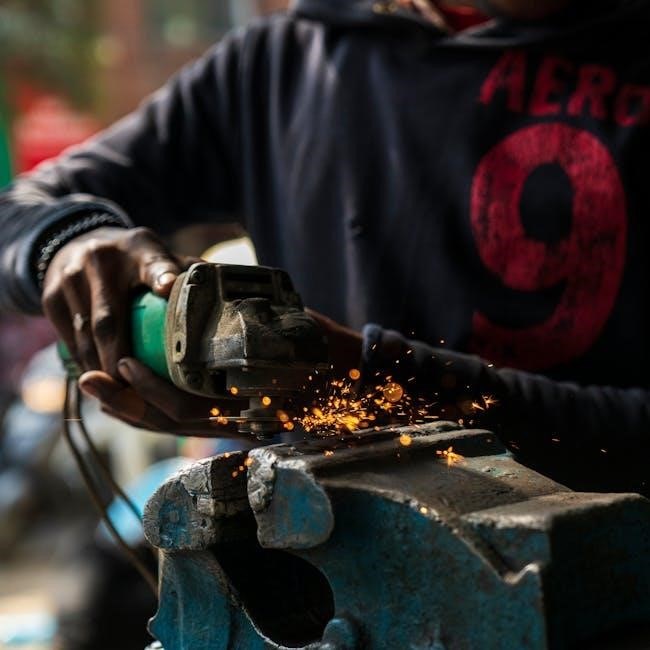
Tips for Optimal Performance
Master consistent grinds by adjusting burrs and maintaining proper grinder hygiene. Experiment with bean origins and roast levels to enhance flavor profiles and brewing techniques.
7.1 Mastering the Grinding Technique
Mastering the grinding technique involves maintaining a steady hand and controlled movements. Start by placing the grinder on a stable surface and hold it firmly to prevent wobbling. Use your dominant hand to turn the handle smoothly, applying consistent pressure to ensure even grinding. Practice adjusting your grip and rotation speed to achieve uniform particle sizes. Pay attention to the sound and feel of the grinder, as these cues can help you identify when the beans are evenly ground. Regular practice will enhance your muscle memory, allowing you to grind efficiently and consistently. Over time, you’ll develop a rhythm that makes the process intuitive and enjoyable, ensuring optimal results for your coffee brewing.
7.2 Achieving Consistency in Grind Size
Achieving consistency in grind size is crucial for optimal coffee extraction. Start by adjusting the grinder’s settings to match your desired grind size for the brewing method. Use a digital scale to measure beans accurately, ensuring uniformity in each batch. Pay attention to the grinder’s alignment and burr sharpness, as misalignment or dull burrs can lead to inconsistent results. Clean the grinder regularly to remove residual coffee oils and particles, which can affect grind quality. Practice grinding small batches to develop muscle memory and refine your technique. Over time, consistent practice and proper maintenance will help you master the art of achieving uniform grind sizes, leading to better coffee flavor and aroma in every cup.

7.3 Experiment with Different Coffee Beans
Experimenting with various coffee beans is a great way to enhance your coffee experience. Different beans offer unique flavors, acidity levels, and aromas, allowing you to discover your preferences. Lighter roasts typically have brighter, fruitier notes, while darker roasts provide deeper, richer flavors. When trying new beans, adjust your grind size to suit the roast level—lighter roasts may require a slightly coarser grind, whereas darker roasts benefit from a finer grind. This experimentation helps you understand how bean origin, roast level, and processing methods impact flavor. Use your manual grinder to fine-tune your settings and unlock the full potential of each bean. Keep track of your favorites and refine your grinding technique to bring out the best in every brew.
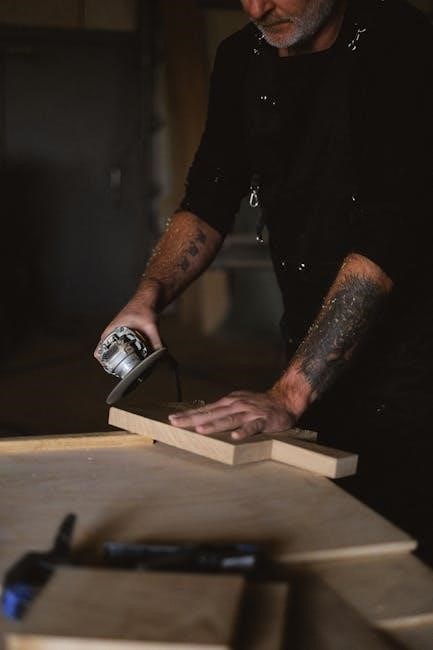
Additional Resources
Explore guides like The Grinders Manual by Peter Clarke for in-depth strategies. Join online forums and communities to share insights and learn from fellow coffee enthusiasts and experts.
8.1 Recommended Reading and Guides
For deeper insights, explore The Grinders Manual by Peter Clarke, a comprehensive guide to mastering manual coffee grinders. Additionally, The Blue Bottle Craft of Coffee offers expert tips on grinding techniques. Online resources like Majesty Coffee’s blog provide detailed tutorials and troubleshooting advice. Websites such as The Spruce Eats and Coffee Confidential share in-depth guides on manual grinding. YouTube channels like “The Coffee Concierge” offer video tutorials for visual learners. These resources cover everything from basic grinding to advanced techniques, ensuring you maximize your manual grinder’s potential. Whether you’re a novice or an enthusiast, these guides will enhance your coffee-making skills and help you brew like a pro.
8.2 Online Communities and Forums
Online communities and forums are invaluable resources for manual grinder enthusiasts. Platforms like Reddit’s r/Coffee and r/Espresso host lively discussions on manual grinders, offering tips, troubleshooting, and recommendations. CoffeeGeek and Home-Barista are dedicated forums where users share detailed reviews of manual grinders and techniques. Facebook groups like “Manual Coffee Grinder Enthusiasts” provide a space for enthusiasts to connect and exchange ideas. Additionally, websites like Majesty Coffee and The Spruce Eats feature community-driven content and guides on manual grinding. These forums are perfect for learning from experienced users, discovering new products, and refining your grinding skills.